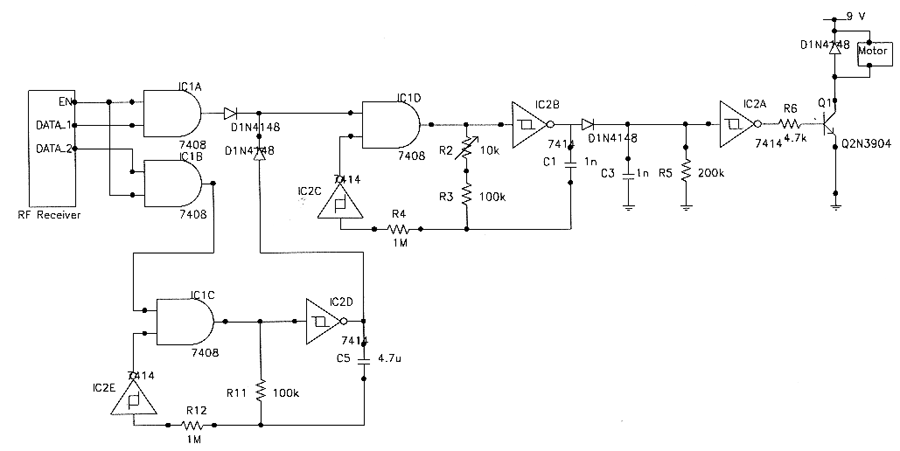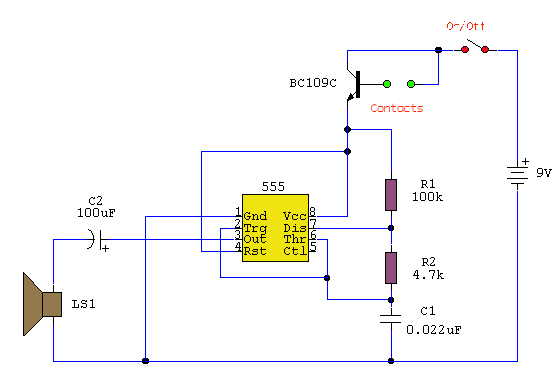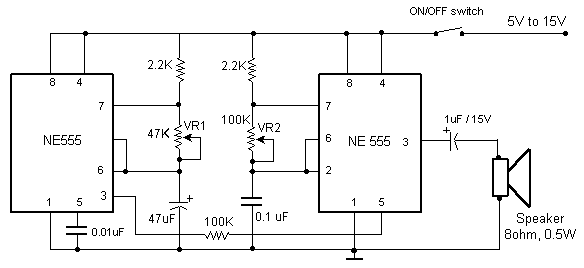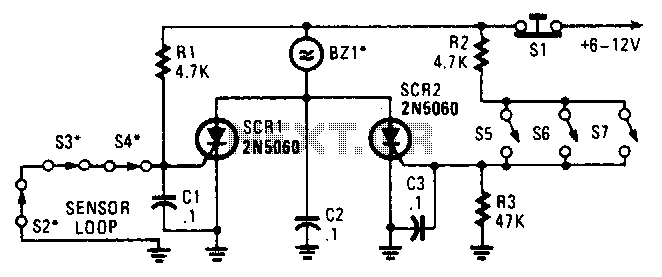
Dummy Alarm Project
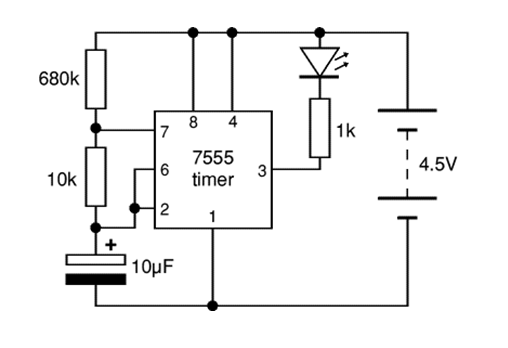
The 7555 timer IC used is a low power version of the standard 555 timer. A super bright red LED is utilized because it provides a bright flash with low current.
The 7555 timer IC is a versatile low-power component that operates similarly to the traditional 555 timer but is designed for applications requiring reduced power consumption. It is commonly used in various timing, pulse generation, and oscillator applications. The 7555 can be configured in astable, monostable, and bistable modes, allowing it to perform a wide range of functions, including generating precise time delays and producing square wave signals.
In the described application, a super bright red LED is employed as the output indicator. This choice is significant for applications where visibility is crucial, as the LED can emit a strong light while consuming minimal current, making it energy-efficient. The LED's brightness is a function of the current flowing through it, which is controlled by the output of the 7555 timer.
When configuring the 7555 in an astable mode, the timing components, typically resistors and capacitors, determine the frequency and duty cycle of the output signal. The output pin can drive the LED directly if the current requirement of the LED is within the output current rating of the 7555. If higher currents are needed, a transistor may be used to amplify the output signal, allowing for greater control over the LED brightness without exceeding the current limits of the timer IC.
The circuit design should include appropriate bypass capacitors near the power supply pins of the 7555 to ensure stable operation and reduce noise. Additionally, a current-limiting resistor must be included in series with the LED to prevent damage from excessive current.
Overall, the integration of the 7555 timer IC with a super bright red LED offers an effective solution for applications requiring low power consumption while still achieving high visibility output.The 7555 timer IC used is a low power version of the standard 555 timer. A ‘superbright red LED is used because this provides a bright flash with a low current. Th.. 🔗 External reference
The 7555 timer IC is a versatile low-power component that operates similarly to the traditional 555 timer but is designed for applications requiring reduced power consumption. It is commonly used in various timing, pulse generation, and oscillator applications. The 7555 can be configured in astable, monostable, and bistable modes, allowing it to perform a wide range of functions, including generating precise time delays and producing square wave signals.
In the described application, a super bright red LED is employed as the output indicator. This choice is significant for applications where visibility is crucial, as the LED can emit a strong light while consuming minimal current, making it energy-efficient. The LED's brightness is a function of the current flowing through it, which is controlled by the output of the 7555 timer.
When configuring the 7555 in an astable mode, the timing components, typically resistors and capacitors, determine the frequency and duty cycle of the output signal. The output pin can drive the LED directly if the current requirement of the LED is within the output current rating of the 7555. If higher currents are needed, a transistor may be used to amplify the output signal, allowing for greater control over the LED brightness without exceeding the current limits of the timer IC.
The circuit design should include appropriate bypass capacitors near the power supply pins of the 7555 to ensure stable operation and reduce noise. Additionally, a current-limiting resistor must be included in series with the LED to prevent damage from excessive current.
Overall, the integration of the 7555 timer IC with a super bright red LED offers an effective solution for applications requiring low power consumption while still achieving high visibility output.The 7555 timer IC used is a low power version of the standard 555 timer. A ‘superbright red LED is used because this provides a bright flash with a low current. Th.. 🔗 External reference
Warning: include(partials/cookie-banner.php): Failed to open stream: Permission denied in /var/www/html/nextgr/view-circuit.php on line 713
Warning: include(): Failed opening 'partials/cookie-banner.php' for inclusion (include_path='.:/usr/share/php') in /var/www/html/nextgr/view-circuit.php on line 713
